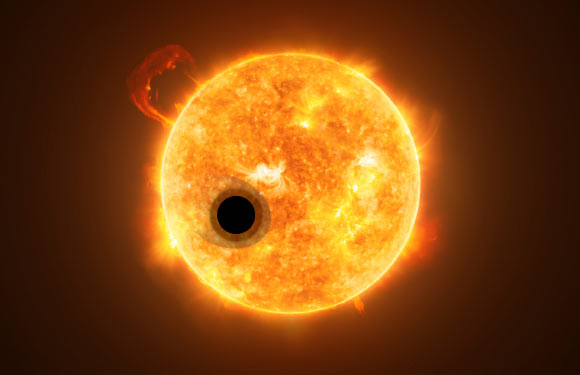An international team of astronomers has detected helium — the second-most abundant element in the Universe after hydrogen — in the atmosphere of WASP-107b, a super-Neptune exoplanet approximately 200 light-years away in the Virgo constellation. This is the first time this inert gas has been detected in the atmosphere of an extrasolar planet.
Helium was first detected as an unknown yellow spectral line signature in sunlight in 1868. English astronomer Norman Lockyer was the first to propose this line was due to a new element, and named it after the Greek Titan of the Sun, Helios.
The research team, led by University of Exeter astronomer Jessica Spake, used the Wide Field Camera 3 instrument on the NASA/ESA Hubble Space Telescope to discover this element in the atmosphere of WASP-107b.
“Helium is the second-most common element in the Universe after hydrogen. It is also one of the main constituents of the planets Jupiter and Saturn in our Solar System,” Spake said.
“However, up until now helium had not been detected on exoplanets — despite searches for it.”
WASP-107b is one of the lowest density planets known: while the planet is about the same size as Jupiter, it has only 12% of Jupiter’s mass.
Orbiting its host star — the highly active K-type main sequence star WASP-107 — every six days, WASP-107b has one of the coolest atmospheres of any of the exoplanets discovered, although at 932 degrees Fahrenheit (500 degrees Celsius) is still radically hotter that Earth.
“The amount of helium detected in WASP-107b’s atmosphere of is so large that its upper atmosphere must extend tens of thousands of miles out into space,” the astronomers said.
“Since its atmosphere is so extended, WASP-107b is losing a significant amount of its atmospheric gases into space — between ~0.1-4% of its atmosphere’s total mass every billion years.”
By analyzing the spectrum of light passing through the upper part of the exoplanet’s atmosphere, Spake and co-authors were able to detect the presence of helium in an excited state.
The significant strength of the signal measured exploited a new technique that doesn’t rely on UV measurements which have historically been used to study upper exoplanet atmospheres.
The astronomers believe this new technique, which uses infrared light, could open up new paths to exploring the atmospheres of more Earth-sized exoplanets found in the further reaches of the Universe.
“The strong signal from helium we measured demonstrates a new technique to study upper layers of exoplanet atmospheres in a wider range of planets,” Spake said.
“Current methods, which use UV light, are limited to the closest exoplanets. We know there is helium in the Earth’s upper atmosphere and this new technique may help us to detect atmospheres around Earth-sized exoplanets — which is very difficult with current technology.”
“Our new method, along with future telescopes such as the NASA/ESA/CSA James Webb Space Telescope, will allow us to analyze atmospheres of exoplanets in far greater detail than ever before,” said team member Dr. David Sing, also from the University of Exeter.
“The helium we detected extends far out to space as a tenuous cloud surrounding the planet. If smaller, Earth-sized planets have similar helium clouds, this new technique offers an exciting means to study their upper atmospheres in the very near future,” said team member Dr. Tom Evans, also from the University of Exeter.
The findings were published online this week in the journal Nature.
Source: Sci News

































Leave a Comment
You must be logged in to post a comment.